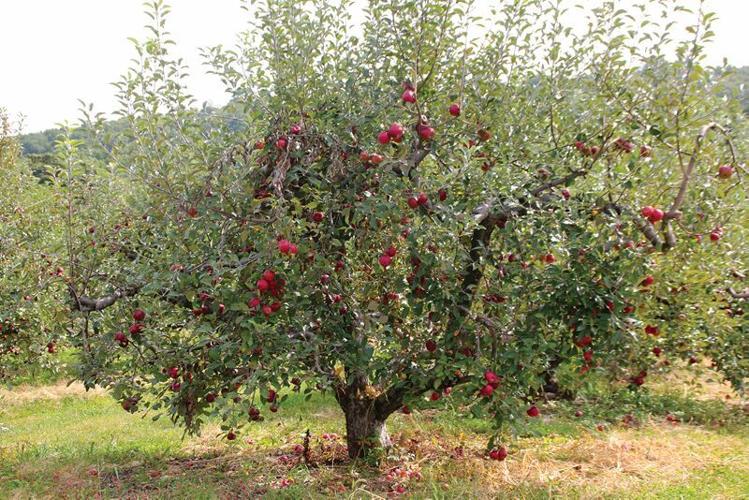HERSHEY, Pa. — Progress is being made on understanding rapid apple tree decline, but much remains to be learned.
Apple growers and researchers from the Mid-Atlantic and as far as western Canada gathered at a day-long Apple Tree Decline Summit on Jan. 27 to share updates prior to the start of the Mid-Atlantic Fruit and Vegetable Convention.
Freeze resistance, weather patterns, viruses, fungal diseases, root crowding, soil conditions, insects and herbicides were all topics in the discussion about what’s contributing to the mysterious condition that causes apple trees to take a quick turn for the worse and die.
Kari Peter, summit host and tree fruit pathology researcher at Penn State’s Fruit Research and Extension Center in Biglerville, said she’s been investigating rapid apple decline since she first came to the center in 2013.
Back then, the malady was mainly associated with M.9 dwarf rootstock, but that has changed, she said, as growers moved away from planting it in recent years and the decline has begun showing up in trees with other rootstocks.

Kari Peter hosts the Apple Tree Decline Summit in Hershey on Jan. 27, 2025.
Peter shared a study that found denser apple tree spacings can decrease root spread and size, which puts trees at greater risk.
“The more we’re compacting the roots, the less soil they contact,” she said. “This is a tree stress.”
Soil type is another factor in root development, playing a greater role than soil volume, Peter said.
And even with irrigation, root health is sensitive to drought and heat stress.
Jason Londo of Cornell University shared his research into the potential role of cold injury in rootstock shank damage and decline.
A period of dormancy must be maintained for trees to develop cold hardiness, or the ability to resist damage from freezing temperatures.
“Tree decline seems to occur after episodes of acute cold exposure in winter,” Londo said. “Anecdotally, large swings in temperature are thought to be more of the problem than consistently cold winters.”
Rootstocks and winter temperature patterns interact to determine freeze risk, Londo said, noting that rootstocks B.9, M.9, G.11 and G.214 performed poorly in warmer winters. G.935 and G.969 were also at risk compared to others in the study, with G.41 and G.257 showing “deep hardiness across years.”
In a mild winter with midwinter warming or “false spring,” he said, apple rootstocks and scions develop less freeze resistance and potential for damage.
Even though Londo found scions (the upper part of the tree grafted to the rootstock) to be less cold-hardy than rootstocks, he said they are also less responsive to temperature changes and don’t seem to be the problem.
“Lots of work remains to document tree decline and implement methods to mitigate damage,” Londo said.

Tami Collum of USDA-ARS explains her research during the Apple Tree Decline Summit in Hershey on Jan. 27, 2025.
Tami Collum of USDA’s Agricultural Research Service outlined her work studying virus infections in apple trees at the Appalachian Fruit Research Station in Kearneysville, West Virginia, as well as partnering with Peter in Pennsylvania.
Her research set out, in part, to see whether certain virus combinations are more common in declining trees.
The question remains, as a 2022 study of declining trees in four Adams County orchards showed both healthy and declining trees harboring similar levels and combinations of viruses.
“There were not huge differences in viruses between asymptomatic and declining trees,” Collum said.
Another question she hopes to answer with ongoing research is whether virus-infested trees are more susceptible to freeze injury.
Between viruses and other pathogens, winter injury, soil profile and the long-term effects of herbicides, the cause of rapid apple decline “is probably going to be a combination of stressers,” Collum said.
According to USDA-ARS, the impact of rapid apple decline is estimated to cost Pennsylvania apple growers about $13,000 per acre and New York apple growers $3,380 per acre.

Jesse McDonald, a researcher from British Columbia, talks about apple tree decline in western Canada during the Apple Tree Decline Summit in Hershey on Jan. 27, 2025.
Jesse MacDonald traveled from the Okanagan Valley in British Columbia to share his experiences with rapid apple decline there since the first major incidence was seen in 2018.
The biologist with Agriculture and Agri-Food Canada said a necrotic canker and clearwing moth infestations are linked with the decline in his region. He is also looking into the potential effects of viruses.
MacDonald observed that declining trees have problems moving water through the graft union.
Temperature swings and less snow cover in recent years are additional factors he is studying.
Other sessions focused on Pennsylvania’s Fruit Tree Improvement Program, USDA’s Pome Quarantine Program, and more on rapid apple decline in New York State, Ontario and North Carolina.
Also on the table was southern blight, a relatively new and ongoing concern for apple growers first observed in Pennsylvania in 2018.
Recent milder winters and warmer summers have allowed the fungal disease once only found in the South to creep northward, Peter said.
Researchers and apple growers still have a long way to go to grasp the complex causes of rapid apple decline, but all the data being generated is helping.
“It’s a lot more nuanced and complicated than we thought,” Peter said. “But the picture is getting less cloudy.”






